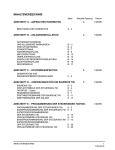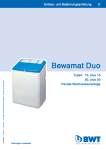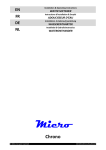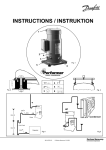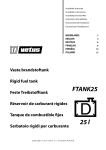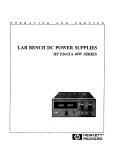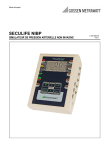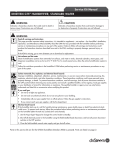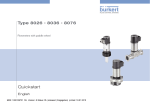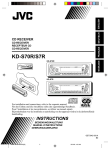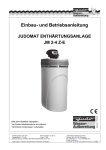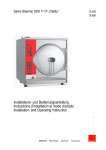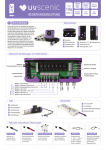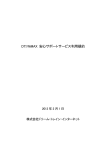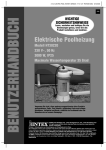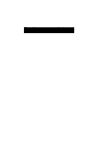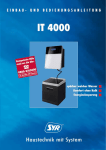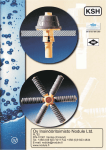Download Performa / LOGIX 740 - 760
Transcript
Performa / LOGIX 740 - 760 Operation Manual Start up and Maintenance Manuel d’utilisation Mise en marche et Maintenance Steuerung Bedienungshandbuch Inbetriebnahme und Wartung En 2 Fr 24 De 46 SYNOPSIS En Valve Features . . . . . . . . . . . . . . . . . . . . . . . . . . . . . . . . . . . . . . . . . . . . . 42 LCD Display . . . . . . . . . . . . . . . . . . . . . . . . . . . . . . . . . . . . . . . . . . . . . . 53 Installation . . . . . . . . . . . . . . . . . . . . . . . . . . . . . . . . . . . . . . . . . . . . . . 64 Location selection . . . . . . . . . . . . . . . . . . . . . . . . . . . . . . . . . . . . . 64 Water line connection . . . . . . . . . . . . . . . . . . . . . . . . . . . . . . . . . 64 Drain line connection . . . . . . . . . . . . . . . . . . . . . . . . . . . . . . . . . 75 Overflow line connection . . . . . . . . . . . . . . . . . . . . . . . . . . . . . . 86 Regenerant line connection . . . . . . . . . . . . . . . . . . . . . . . . . . . . . 86 Start-up of your softener . . . . . . . . . . . . . . . . . . . . . . . . . . . . . . . . 97 Step 1 - Program system size . . . . . . . . . . . . . . . . . . . . . . . . . . . . 97 Step 2 - Placing conditioner into operation . . . . . . . . . . . . . . . . . 97 Step 3 - Basic programming . . . . . . . . . . . . . . . . . . . . . . . . . . . . . 11 9 World LOGIX settings . . . . . . . . . . . . . . . . . . . . . . . . . . . . . . . . . 14 12 Step 4 - Capacity . . . . . . . . . . . . . . . . . . . . . . . . . . . . . . . . . . . . . 15 13 Step 5 - Hardness setting . . . . . . . . . . . . . . . . . . . . . . . . . . . . . . 15 13 Resetting the control to unprogrammed . . . . . . . . . . . . . . . . . . . . . . . 15 13 Manual regenerations . . . . . . . . . . . . . . . . . . . . . . . . . . . . . . . . . . . . . . 15 13 Options . . . . . . . . . . . . . . . . . . . . . . . . . . . . . . . . . . . . . . . . . . . . . . . . . 16 14 Flow diagrams . . . . . . . . . . . . . . . . . . . . . . . . . . . . . . . . . . . . . . . . . . . . . 18 16 Valve exploded view . . . . . . . . . . . . . . . . . . . . . . . . . . . . . . . . . . . . . . . 20 18 Nomenclature . . . . . . . . . . . . . . . . . . . . . . . . . . . . . . . . . . . . . . . . . . . . 21 19 2 En 3 Complete Valve - Front view En One piece valve disc spring Valve discs Optical sensor Control module mount Refill Controller Regenerant tank tube connection Injector and cap Complete Valve - Back view Camshaft Motor Outlet Drain Inlet Backwash drain control 4 Injector screen filter LCD Display En LCD Display Down button Set button Up Button Manual regen button Chlorine generator outlet (EU and 742/762 versions only) AC adapter input (low voltage Lockout connection (772 only) Secondary valve motor control (772 only) Sensor input 716 by turbine 760/762 Dry contact signal input 740/742 5 INSTALLATION En Location selection Location of a water treatment system is important. The following conditions are required : ● ● ● ● ● ● ● ● ● ● ● Level platform or floor. Room to access equipment for maintenance and adding regenerant (salt) to tank. Ambiant temperatures over 34°F (1°C) and below 120°F (49°C). Water pressure below 120 psi (8.27 bar) and above 20 psi (1.4 bar). Constant electrical supply to operate the controller. Total minimum pipe run to water heater of ten feet (three meters) to prevent backup of hot water into system. Local drain for discharge as close as possible. Water line connections with shutoff or bypass valves. Must meet any local and state codes for site of installation. Valve is designed for minor plumbing misalignments. Do not support weight of system on the plumbing. Be sur all soldered pipes are fully cooled before attaching plastic valve to the plumbing. Water line connection A by-pass valve system should be installed on all water conditioning systems. Bypass valves isolate the conditioner from the water system and allow unconditioned water to be used. Service or routine maintenance procedures may also require that the system is bypassed. Figure 1 and 2 show the three common bypass methods. In Out In Out Figure 1 256 By-pass for use with 255 valve body. Normal operation Figure 2 Typical globe valve by-pass system In by-pass Water conditioner Water conditioner Normal operation In by-pass 6 Drain line connection NOTE : Standard commercial practices are expressed here. Local codes may require changes to the following suggestions. Check with local authorities before installing a system. 1. The unit should be above and not more than 20 feet (6.1m) from the drain. Use an appropriate adapter fitting to connect 1/2-inch (1.3cm) plastic tubing to the drain line connection of the control valve. 2. If the backwash flow rate exceeds 5 gpm (22.7 Lpm) or if the unit is located 20-40 feet (6.1-12.2 m) from drain, use 3/4-inch (1.9 cm) tubing. Use appropriate fittings to connect the 3/4-inch tubing to the 3/4-inch NPT drain connection on valve. 3. The drain line may be elevated up to 6 feet (1.8 m) providing the run does not exceed 15 feet (4.6m) and water pressure at the conditioner is not less than 40 psi (2.76 bar). Elevation can increase by 2 feet (61 cm) for each addditional 10 psi (0.69 bar) of water pressure at the drain connector. 4. Where the drain line is elevated but empties into a drain below the level of the control valve, form a 7-inch (18 cm) loop at the far end of the line so that the bottom of the loop is level with the drain line connection. This will provide an adequate siphon trap. Where the drain empties into an overhead sewer line, a sink-type trap must be used. Secure the end of the drain line to prevent it from moving. air gap Figure 3 Drain line connection drain WARNING : Never insert drain line directly into a drain, sewer line or trap (figure 3). Always allow an air gap between the drain line and the wastewater to prevent the possibility of sewage being back-siphoned into the conditioner. 7 En Overflow line connection En In the event of a mal function, the regenerant tank overflow will direct “overflow” to the drain instead of spilling on the floor.This fitting should be on the side of the cabinet or regenerant tank. Most tank manufacturers include a post for the tank overflow connector. To connect the overflow line, locate hole on side of tank. Insert overflow fitting into tank and tighten with plastic thumb nut and gasket as shown (figure 4). Attach length of 1/2-inch (1.3 cm) I.D. tubing (not supplied) to fitting and run to drain. Do not elevate overflow higher than overflow fitting. Do not tie into drain line of control unit. Overflow line must be a direct, separate line from overflow fitting to drain, sewer or tub. Allow an air gap as per drain line instructions. overflow fitting drain tubing Figure 4 secure hose in place air gap drain Regenerant line connection The regenerant line from the tank connects to the valve. Make the connections and hang tighten. Be sure that the regenerant line is secure and free from air leaks. Even as small leak may cause the regenerant line to drain out, and the conditioner will not draw regenerant from the tank. This may also introduce air into the valve causing problems with the valve operation. Figure 5 Regenerant line connection 8 START-UP OF YOUR SOFTENER Preliminary check of hydraulic parameters of the valve This step must have been done by your OEM. You need to check that there is no mistake. In fact, every setting stored in the electronic is largely dependant of hydraulic parameters (injector/backwash) installed on the valve. Please check that you are using the correct injector and backwash control in accordance with the used pressure tank (see table page 14). Initial start-up step-by-step instructions Step 1 - Program system size This step may be performed by your system’s OEM manufacturer. In this case, proceed to step 2. ● Input system size - resine volume - in cubic feet or liters. ● Use UP and DOWN buttons to scroll through resin volume choices. ● Choose the nearest volume to your actual system size. ● To choose a 3-cycle filter operation - press the DOWN button until an “F” is displayed. ● Press the SET button to accept the system size you’ve selected. If incorrect setting is programmed, see “Resetting the control” on page 15. Step 2 - Placing conditioner into operation (conditioner start-up) After you have performed the previous initial power-up steps, you will need to place the conditioner into operation. Follow these steps carefully, as they differ from previous Autotrol valve instructions. 1. Remove the cover from the valve. Removing the cover will allow you to see that the camshaft is turning, and in which cycle the camshaft is currently positioned. 2. With the supply water for the system still turned off, position the bypass valve to the “not in bypass” (normal operation) position. 3. Hold the REGEN button on the controller down for 5 seconds.This will initiate a manual regeneration. The controller will indicate that the motor is turning the camshaft to the cycle C1 (backwash) position by flashing an hourglass. The controller will display the total regen time remaining. If you press and hold the SET button, the controller will indicate the time remaining in the current cycle. 9 En 4. Fill the media tank with water. En A. While the controller is in cycle C1 (backwash), open the water supply valve very slowly to approximately the 1/4 open position. B. When all of the air has been purged from the media tank (water begins to flow steadily from the drainline), open the main supply valve all of the way. This will purge the final air from the tank. C. Allow water to run to drain until the water runs clear from the drain line. This purges any refuse from the media bed. D. Turn off the water supply and let the system stand for about five minutes.This will allow for any air trapped to escape from the tank. 5. Add water to the regenerant tank (initial fill) - Conditioner only. A. With a bucket or hose, add approximately 4 gallons (15 liters) of water to the regenerant tank. B. If the tank has a salt platform in the bottom of the tank, add water until the water level is approximately 1 inch (25 mm) above the platform. 6. Engage the refill cycle to prime the line between the regenerant tank and the valve Conditioner only. A. Slowly open the main water supply valve again, to the fully open position. Be sure not to open too rapidly as that would push the media out the media tank. B. Advance the controller to the refill position. From cycle C1 (backwash), press and hold the SET button. This will display the current cycle. While pressing the SET button, press the UP arrow to advance to the next cycle. Continue to advance through each cycle until you have reached cycle C8 (refill). C. With the water supply completely open, when you arrive at cycle C8 (refill), the controller will direct water down through the line to the regenerant tank. Let the water flow through the line until all air bubbles have been purged from the line. D. Do not let the water flow down the line to the tank for more than one to two minutes, or the tank may overfill. E. Once the air is purged from the line, press the SET button and the UP button simultaneously to advance to cycle C0 (treated water) position. 7. Draw water from the regenerant tank. A. From the treated water position (cycle C0), advance the valve to the draw regenerant position. Hold the REGEN button down for five seconds. The controller will begin a manual regen, and advance the control valve to the cycle C1 (backwash). Press the SET and UP buttons to advance to cycle C2 (draw). B. With the controller in this position, check to see that the water in the regenerant tank is being drawn out of the tank. The water level in the tank should recede very slowly. 10 C. Observe the water being drawn from the regenerant tank for at least three minutes. If the water level does not recede, or goes up, reference the Troubleshooting section. 8. If the water level is receding from the regenerant tank you can then advance the controller back to the treated water (C0) position by pressing SET and UP buttons simultaneously to advance the controller to the C0 position. 9. Finally, turn on a faucet plumbed after the water conditioner. Run the faucet until the water runs clear. Step 3 - 740/760 Basic Programming NOTE : If a button is not pushed for thirty seconds, the controller returns to normal operation mode. Pushing the regenerate button immediately returns the controller to normal operation. ● Time of day When the time of the day is displayed, push SET. The time will flash. Use the arrows buttons to increase/decrease the time. Push SET to enter the selection. ● Day of the week The day of the week does not have a default setting. It is entered at power-up.To change the current day, push SET when day of week is displayed. A flag will flash beneath the current day. Use the arrow buttons to change. Push SET to enter the selection. ● Time of regeneration This is set for 2:00 AM as the default.The controller does not account for daylight savings time. To change this setting, push SET. Use the arrow buttons to increase/decrease the time. Push SET to enter the selection. ● Number of days between regeneration The controller can be programmed to regenerate automatically from a 1/2 (.5) day to a 99 day frequency. The 1/2 day regeneration mode will regenerate at the “time of regeneration”, as well as 12 hours opposite from that time. For example, the controller will regenerate at 2 AM and at 2 PM on the same day. 740 The default setting is three days for the 740. To change, push SET when this setting is displayed. Use the arrow buttons to increase/decrease. Push SET to enter the selection. 760 The default setting is 0 days for the 760. To change, push SET when this setting is displayed. Use the arrow buttons to increase/decrease. Push SET to enter the selection. 11 En ● Specific day of week regeneration (740 only) En 740 To change the controller to regenerate on specific days, set the number of days between regeneration to zero. After this has been completed, the arrow on the left side of the display will be pointing to regeneration time/day. Press the SET button and the display will show a flashing cursor at the top under Sunday. The day of week can be selected when the cursor is below it. To toggle the day on/off, the triangular cursor must be below that day and flashing. The UP or DOWN buttons are used to turn the days flag on/off. If the cursor is in position but steady on, use the UP or DOWN buttons. To move the cursor when it is flashing push the SET button once. This will move the cursor one position to the right and change the status to steady on. WARNING : Setting days between regeneration to zero will cause the system to not regenerate. This setting is used for selecting regeneration on specific days or to use with a remote regeneration input. See below. NOTE : Regeneration on specific day is used to provide regeneration when water demands are not steady. Example : if the weekdays have low usage and the weekend is high, then regeneration every three days will not meet the requirements. ● Calendar override (760 only) 760 The controller can be programmed to regenerate automatically from a 1/2 (.5) day to a 99 day frequency. The 1/2 day regeneration mode will regenerate at the “time of regeneration”, as well as 12 hours from that time. For example, the controller will regenerate at 2 AM and at 2 PM on the same day. The default setting is 0 days. To change, push SET when this setting is displayed. Use the arrow buttons ton increase/decrease. Push SET to enter the selection. 12 ● Amount of regenerant used per regeneration If the installation is a 3-cycle filter, skip to Filter Backwash Time. The amount of regenerant does not apply. The Logix series controllers are set-up to automatically calculate the capacity of the system by multiplying the resin/media volume that was entered earlier into the controller, with the regenerant amount entered by the dealer/installer. This eliminates the need for salting efficiency tables. The default setting is “S” (Standard salt) To enable the most simple programming possible on the 740 controllers, the dealer/installer has three salt amount options to choose from. These are set up to give the installation the maximum performance based on the inputs by the dealer/installer. The three salting options are : High salt This setting gives the installation the highest capacity possible for that resin volume. This is a great setting for applications with very high hardness, many occupants or for applications where the dealer wants to always ensure that the application has soft water. This setting may tend to use less water over the course of a year, because it generally needs to be regenerated less often. This setting is displayed as an “H”. Standard salt This is the default setting for the controller. This setting fits most applications around the word. It gives you an efficient use of salt, while maintaining a large enough capacity to regenerate every three days for most applications. This setting is displayed as an “S”. Low salt This setting is provided to give your installation the maximum efficiency of salt usage, as measured in grains of hardness softened per pound of salt used (grams of CaCO3 removed per kilogram of salt used). This setting is useful for markets where highy efficient conditioners are expected or required by the consumers or law. This setting is displayed as an “L”. 13 En World Logix Settings En Tank Volume (liters) Max Height Inj. 6 18 E 6 35 7 44 8 44 9 48 10 54 12 54 13 54 14 65 yellow E yellow F peach G tan H Lt purple J Lt blue K pink L orange L orange Media Volume (liters) 5 10 15 20 30 35 40 50 80 Salt Setting L S H L S H L S H L S H L S H L S H L S H L S H L S H Total Salt Amount per regeneration (kgs) Estimated capacity (kg) 0,2 0,45 0,91 0,45 0,91 1,81 0,68 2,04 3,40 1,13 3,17 4,98 1,58 4,08 6,80 1,80 4,99 8,62 2,27 6,12 10,20 2,94 8,16 13,61 4,53 12,25 20,41 0,1 0,2 0,3 0,3 0,4 0,5 0,4 0,8 1,0 0,7 1,2 1,5 1,0 1,6 2,0 1,2 2,1 2,5 1,5 2,5 3,0 2,0 3,2 3,9 3,0 4,9 5,8 H = High salt - approximately 15 lbs. per cu. ft. of media S = Standard salt - approximately 9 lbs. per cu. ft. of media L = Low salt - approximately 3.3 lbs. per cu. ft. of media 14 Step 4 - Capacity The 740 controller is designed to estimate capacity of the system by multiplying the initial resin/media volume by the regenerant amount programmed in under “Amount of regenerant used per regeneration”. An estimated total system capacity is displayed in kilograins (kilograms CaCO3) that can be removed by the fully regenerated media bed. This value is derived by standard water treatment industry norms. The system capacity is displayed merely for the installers reference when determining regeneration frequency. This value is displayed, but cannot be directly changed of the 740 time clock controller. ● Capacity is only displayed for information purposes on 740 control. It does not (and cannot) need to be changed. If using 740 control, programming is complete, the control will return you to the normal operation mode ● To change capacity on 760 control, presse the SET button to make default capacity flash. Use the UP and DOWN buttons to increment to the desired capacity. Presse the SET button to accept the setting and advance to next parameter. 740 760 Step 5 - Hardness setting (760 only) 760 The hardness setting is set in grains per gallon (ppm CaCO3). The hardness is divided into the total capacity setting, giving a total volume of water that can be conditioned before a regeneration is needed. To set, press SET when P8 is displayed, and use the UP or DOWN buttons to increment. Press SET again to accept the setting. Resetting the control to unprogrammed The control can be returned to its unprogrammed state. To erasse all information that was programmed in : 1. Press the DOWN arrow and the SET button for five seconds. 2. Press and hold the SET button for five seconds. 3. The display will show three dashes and a decimal point. 4. The display will be flashing. The display indicates all programming has been erased. Manual regeneration For a delayed regeneration (at the next set time of regeneration) ● Push the REGEN button once. The recycle symbol will be flashing on the display. Push the REGEN button again to cancel. 15 En For an immédiate regeneration : Push and hold the REGEN button for five seconds. The display will show the regeneration symbol. The camshaft will start rotating to cycle C1. ● En For an immédiate, double regeneration : ● After an immediate manual regeneration has begun, and the camshaft has rotated to cycle C1, you can initiate a second immediate manual regeneration. ● Press and hold the REGEN button for 5 seconds once the camshaft has begun cycle C1. ● The display will show a x2 icon indicating that a second manual regeneration will occur after the current regeneration is completed. OPTIONS Logix Chlorine Generator (Check Salt Light) The Logix 740C/742 and 760C/762 controls have the capability to produce a low level of chlorine to chlorinate the resin bed during regeneration. Included with the chlorine generator is the check salt light which indicates when the end user needs to add salt to the regenerant tank. Potassium chloride or sodium chloride may be used. Installing the chlorine generator is simple. Installation instructions Chlorine Generator Outlet (740C/742 and 760C/742 versions only) STEP 1 - Remove the Logix control from the valve and disconnect power. ● STEP 2 - Insert the small chlorine generator connector and wire to the back of the Logix control at the connection labled “Chlorine Generator Outlet 740C/742 and 760C/742”. Logix control removal procedure can be found in the Logix technical manual. ● STEP 3 - Remove the existing refill controler and ball from the Back on Logix Control valve and replace it with the chlorine generator refill flow control. See the illustrations to the left for the location of the refill controler. ● STEP 4 - Insert the small chlorine generator connector and wire to the back of the Logix control at the connection labled “Chlorine Generator Outlet 740C/742 and 760C/742”. Logix control removal procedure can be found in the Logix technical manual. ● STEP 5 - Reconnect power to the logix control and reinstall the control to the valve ● Programmation No programming is necessary for the chlorine generator to work properly on the 740C/760C. After the chlorine generator senses regenerant for the first time it will be functional. There is a check salt light on the front of the Logix control that will illuminate when there is no regenerant present during the regenerant draw. Check Salt Light Refill controler Injector and cap 16 255 Blending Valve Kit Kit (P/N 1239760) for the 255/700 series includes : - Nut (10-32) and Adjusting scew En Installation Insert the nut into the Blending Valve orifice located near the Bypass Flapper shown below. Insert the screw through the top plate and then through the nut (Figure A). Figure A Tighten the screw until it touches the Bypass Flapper (Fig. B). Figure B Operation Tightening the adjusting screw will force the Bypass Flapper open. The open Flapper will allow untreated (hard) water to blend with the treated water supply. As the adjusting screw is turned in, the hardness of the oulet water increases (Fig. C). Figure C Figure D Loosening the adjusting screw will allow the Bypass Flapper to close. The closing action will blend less untreated water into the oulet flow. To blend a specific amount of hardness into outflow, adjust the screw and test the water. Repeat the procedure as needed until the desired hardness level is reached. 17 Flow Diagram En Rinse Drain (6) Outlet (4) Bypass (2) Backwash/Drain (7) Refill (5) Inlet (3) Regenerant (1) C0 Treated water position C1 Backwash 1 position (normal position) Valve Nr 1 - Closed 2 - Opened 3 - Opened 4 - Closed 5 - Closed 6 - Closed Valve Nr 1 - Closed 2 - Closed 3 - Opened 4 - Opened 5 - Closed 6 - Opened C2 Draw position Valve Nr 1 - Opened 2 - Closed 3 - Closed 4 - Opened 5 - Opened 6 - Closed C3 Slow Rinse position Valve Nr 1 - Opened 2 - Closed 3 - Closed 4 - Opened 5 - Opened 6 - Closed 18 C4 System Pause position C5 Fast Rinse 1 position (repressurize) En Valve Nr 1 - Closed 2 - Closed 3 - Closed 4 - Opened 5 - Closed 6 - Closed Valve Nr 1 - Closed 2 - Opened 3 - Closed 4 - Opened 5 - Opened 6 - Closed C6 Backwash 2 position Valve Nr 1 - Closed 2 - Closed 3 - Opened 4 - Opened 5 - Closed 6 - Opened C7 Fast Rinse 2 position Valve Nr 1 - Closed 2 - Opened 3 - Closed 4 - Opened 5 - Opened 6 - Closed C8 Refill Valve Nr 1 - Opened 2 - Opened 3 - Opened 4 - Closed 5 - Closed 6 - Closed 19 PERFORMA EXPLODED VIEW En 20 268 VALVE NOMENCLATURE Code 1 2 3 4 5 6 7 8 9 10 * * 11 Part Number 1294650 1033784 1010429 1010428 1235640 1235341 1236246* 1001404 1040459 1001986 1000250 1239760 1031402 1031403 1031404 1031405 1031406 1031407 1006093 12 13 14 15 16 17 1235353 1236251 1236269 1000226 1035730 1035731 1035732 1035733 1035734 1035735 1035736 1000269 1000209 1000210 1000211 1000212 1002130 1000214 1000215 Description 268 Valve Assembly, w/o flow controls 268 Tank adapter New style O-Ring BN O-Ring EP Top plate, 268 Valve, 700/860 Series controller Spring One piece 268 valve Cover,Valve, 268/Performa, 700/860 Series controller O-Ring group : tank adapter O-Ring group : piping boss 13/16 inch rubber insert (optional) Valve disk kit - standard Blending valve kit 900/700 series top plate Locking bar English language locking bar French language locking bar German language locking bar Italian language locking bar Japanese language locking bar Spanish language locking bar Locking bar screw N° 8-9/196 inch Camshaft options Cam 268/700-860 series valve, STD, black Cam 268/700-860 series valve,TWIN, tan (insert) Motor/Optical cable assembly, 700 series controller Screen/Cap Assembly w/ O-Ring Injector (high efficiency) Options “E” Injector (high efficiency) - yellow “F” Injector (high efficiency) - peach “G” Injector (high efficiency) - tan “H” Injector (high efficiency) - lt purple “J” Injector (high efficiency) - lt blue “K” Injector (high efficiency) - pink “L” Injector (high efficiency) - orange Injector cap with O-Ring Drain control assembly with O-Ring N°7 (1.2 gpm; 4.5 Lpm) N°8 (1.6 gpm; 6.1 Lpm) N°9 (2.0 gpm; 7.6 Lpm) N°10 (2.5 gpm; 9.5 Lpm) N°12 (3.5 gpm; 13.2 Lpm) N°13 (4.1 gpm; 15.5 Lpm) N°14 (4.8 gpm; 18.2 Lpm) 21 Qty 1 1 1 1 1 1 1 1 1 1 1 1 1 1 1 1 1 1 1 En 268 VALVE NOMENCLATURE En Code 18A 18B 19 20 21 22 * Part number 1000222 1243510 1032416 1032417 1235373 1238861 1030502 1033066 Description Regenerant Refill controller, No ball Regenerant Refill controller Air Check Kit Air Check Kit 3/8 inch male Air Check Kit 1/4 inch male Module, Sensor, Photo interupter Motor w/Spacer & Pinion, 700 Series controller, 12V, 50/60 Hz Ball Flow Control New to Old Style Aircheck Adapter 22 Qty 1 1 1 1 1 1 740/760 Control En Code Part Number Description 1 2 3 4 5 6 7 8 9 Kit chlorine generator Extension cable for remote blezel Overlay 740 Overlay 740C Overlay 740F Overlay 760 Overlay 760C Overlay 760F Transformer 1234336 1242411 1263910 1263911 1263912 1263913 1263914 1263914 1000814 Bypass 1265 Code Part Number Description 5 * * 1040930 1034302 1030541 By-pass 1265 Repair kit (rotor seals & clips) Garniture for 1” pipe or tube 12 KIT-P3 KIT-P4 KIT-P7 KIT-P8 KIT-PV KIT-PV-1 KIT-PV-34 3/4 inch BSPT Brass pipe adapter kit 1 inch BSPT Brass pipe adapter kit 22 mm Copper Tube adapter kit 28 mm Copper Tube adapter kit 32 mm PVC Tube adapter kit 1 inch PVC Tube adapter kit 3/4 inch PVC Tube adapter kit 23 SOMMAIRE Vanne complète - Corps de vanne et Bypass . . . . . . . . . . . . . . . . . . . . 26 2 Ecran affichage LCD . . . . . . . . . . . . . . . . . . . . . . . . . . . . . . . . . . . . . . . . 27 3 Installation . . . . . . . . . . . . . . . . . . . . . . . . . . . . . . . . . . . . . . . . . . . . . . 28 4 Sélection de l’emplacement . . . . . . . . . . . . . . . . . . . . . . . . . . . . . 28 4 Raccord ligne d’eau . . . . . . . . . . . . . . . . . . . . . . . . . . . . . . . . . . . 28 4 Raccord au tuyau d’évacuation . . . . . . . . . . . . . . . . . . . . . . . . . . 29 5 Raccord tuyauterie trop-plein . . . . . . . . . . . . . . . . . . . . . . . . . . . 30 6 Raccord tuyauterie saumure . . . . . . . . . . . . . . . . . . . . . . . . . . . . 30 6 Mise en route de l’adoucisseur . . . . . . . . . . . . . . . . . . . . . . . . . . . 31 7 Fr Etape 1 - Programmation de la taille du système . . . . . . . . . . . . 31 7 Etape 2 - Démarrage hydraulique . . . . . . . . . . . . . . . . . . . . . . . . . 31 7 Etape 3 - Programmation des contrôleurs . . . . . . . . . . . . . . . . . 33 9 Réglages LOGIX Monde . . . . . . . . . . . . . . . . . . . . . . . . . . . . . . . 36 12 Etape 4 - Capacité estimée . . . . . . . . . . . . . . . . . . . . . . . . . . . . . 37 13 Etape 5 - Entrée de la dureté . . . . . . . . . . . . . . . . . . . . . . . . . . . 37 13 Réinitialisation du contrôleur . . . . . . . . . . . . . . . . . . . . . . . . . . . . . . . . 37 13 Régénérations manuelles . . . . . . . . . . . . . . . . . . . . . . . . . . . . . . . . . . . . 37 13 Options . . . . . . . . . . . . . . . . . . . . . . . . . . . . . . . . . . . . . . . . . . . . . . . . . 38 14 Diagramme de flux . . . . . . . . . . . . . . . . . . . . . . . . . . . . . . . . . . . . . . . . 40 17 Vue éclatée . . . . . . . . . . . . . . . . . . . . . . . . . . . . . . . . . . . . . . . . . . . . . . . 42 19 Nomenclature . . . . . . . . . . . . . . . . . . . . . . . . . . . . . . . . . . . . . . . . . . . . 43 20 24 Fr 25 Vanne complète - Vue de face Ressort de clapets en une pièce Clapets Capteur optique Support du module de contrôle Contrôle de remplissage Fr Raccord Tuyau Régénérant Injecteur et bouchon Vanne complète - Vue arrière Arbre à cames Moteur Sortie Egout Entrée Contrôleur de détassage à l’égout 26 Crépine d’injecteur Ecran d’affichage LCD Affichage à cristaux liquides Flèche bas Bouton régé. manuelle Bouton réglage Flèche haut Fr Sortie générateur chlore (versions EU et 742/762 uniquement) Entrée adaptateur AC (faible voltage) Raccord verrouillage (772 uniquement) Contrôle du moteur de vanne secondaire (772 uniquement) Entrée capteur 716 par turbine 760/762 - Signal 740/742 27 INSTALLATION Sélection de l’emplacement L’emplacement d’un système de traitement d’eau est important. Les conditions suivantes sont requises : Fr ● Plate-forme de niveau ou sol plan. ● Espace pour accéder à l’appareil pour la maintenance et l’ajout de sel dans le bac. ● Température ambiante supérieure à 1°C et inférieure à 49°C. ● Pression de l’eau inférieure à 8,3 bars et supérieure à 1,4 bars. ● Alimentation électrique constante pour le fonctionnement du contrôleur. ● Longueur totale minimum du tuyau relié au chauffe-eau de 3 mètres pour empêcher les retours d’eau chaude dans le système. ● Evacuation locale pour rejet à l’égout aussi proche que possible. ● Raccords à la tuyauterie d’eau avec vannes d’arrêt ou de by-pass. ● Doit respecter toutes les normes locales et nationales pour le lieu d’installation. ● La vanne est conçue pour des défauts mineurs d’alignement. N’appuyez pas le poids du système sur la plomberie. ● Assurez-vous que tous les raccords soudés ont totalement refroidi avant de relier la vanne en plastique à la plomberie. Raccord ligne d’eau Un by-pass devrait être installé sur tous les sytèmes d’adoucissement de l’eau. Les vannes de by-pass isolent l’adoucisseur du système d’eau et permettent une utilisation d’eau illimitée. Les procédures de révision ou d’entretien de routine nécessitent parfois que le système soit en by-pass. La figure 1 présente le by-pass disponible en option avec la vanne 268 Fonctionnement normal entrée sortie En by-pass entrée sortie Figure 1 By-pass 1265 à utiliser avec le corps de vanne 268. Adoucisseur d’eau 28 Adoucisseur d’eau Raccord au tuyau d’évacuation REMARQUE : Les pratiques commerciales standards sont détaillées ici. Les normes locales nécessiteront parfois des modifications des instructions fournies dans ce manuel.Vérifiez auprès des autorités locales avant d’installer un matériel. 1. Si le débit de détassage excède 5 gpm (1,2 m3/h) ou si l’appareil est placé à 6-12 m de l’évacuation, utilisez un tuyau de 20 mm. Utilisez les raccords appropriés pour relier le tuyau de 20 mm au raccord d’évacuation NPT 20 mm sur la vanne. 2. Le tuyau d’évacuation peut être élevé jusqu’à 1,80 m au-dessus de la sortie égout de la vanne à condition que sa longueur n’excède pas 4,6 m et que la pression de l’eau au conditionneur ne soit pas inférieure à 2,8 bars. L’élévation peut être augmentée de 60 cm pour chaque pression de l’eau supplémentaire de 0,7 bar au niveau du raccord d’évacuation. 3. Lorsque le tuyau d’évacuation est en hauteur et ne déverse dans un égout situé en dessous du niveau de la vanne multivoie, faites une boucle de 20 cm à l’extrémité du tuyau afin que le bas de la boucle se trouve au niveau du raccord du tuyau d’évacuation. Ceci constituera un siphon tout à fait adapté. Là où l’évacuation s’écoule dans un rejet à l’égout en hauteur, utilisez un siphon de type bouche d’évier. Fixez l’extrémité du tuyau d’évacuation pour l’empêcher de bouger. disrupteur de charge Figure 2 Raccord tuyau d’évacuation égout ATTENTION : N’insérez jamais de tuyau d’évacuation directement dans un égout, un rejet à l’égout ou un siphon (Figure 2). Laissez toujours un espace d’air entre le tuyau d’évacuation et le rejet à l’égout pour éviter que les eaux usées repassent par le siphon dans l’adoucisseur. 29 Fr Raccord tuyauterie trop-plein Dans l’éventualité d’une défaillance, le trop-plein du bac à sel “débordera” directement à l’égout au lieu de s’écouler sur le sol. N’élevez pas la tuyauterie de trop-plein au-dessus du raccord de trop-plein. Ne raccordez pas au tuyau d’évacuation de l’unité de contrôle. Le tuyau de tropplein doit être un tuyau direct et séparé du rejet à l’égout. Laissez un espace d’air comme pour les instructions du tuyau d’évacuation. raccord de trop-plein tuyau d’évacuation Figure 3 fixez le raccord en place disrupteur de charge Fr égout Raccord tuyauterie saumure La tuyauterie au bac à sel se branche sur la vanne. Effectuez les raccords et serrez à la main. Assurez-vous que la tuyauterie de saumure est bien fixée et exempte de fuites d’air. Même une fuite minime risque de remplir le bac à sel, et l’adoucisseur n’aspirera pas de saumure pour la bouteille. Cela risque également d’introduire de l’air dans la vanne et de nuire à son fonctionnement. Figure 4 raccord tuyauterie régénérant 30 MISE EN ROUTE DE L’ADOUCISSEUR Vérification préventive des paramètres hydrauliques de la vanne Cette étape a dû être parfaitement configurée par votre assembleur. Il convient de vérifier qu’aucune erreur n’ait été faite. En effet, les réglages rentrés dans l’électronique sont dépendants intégralement des paramètres hydrauliques (inj./backwash) présent sur la vanne. Vérifier la conformité de votre contrôleur de détassage et de votre injecteur par rapport au diamètre de la bouteille (cf. tableau page 36) Instructions étape par étape de la mise sous tension initiale Etape 1 - Programmation de la taille du système Il est possible que cette étape ait été réalisée par l’assembleur de votre système. Dans ce cas passez à l’étape 2. ● Brancher électriquement le contrôleur. Si l’arbre à câmes n’est pas en service, le moteur tourne et le repositionne immédiatement. ● Entrée taille système - volume de résine - en litres. ● Utilisez les flèches HAUT et BAS pour faire défiler les choix de volume de résine. ● Choisissez le volume le plus proche de la taille de votre système. ● Pour choisir le mode filtre à 3 cycles : appuyez sur la flèche BAS jusqu’à ce qu’un “F” s’affiche. ● Appuyez sur SET pour valider la taille de système sélectionnée. Si un réglage incorrect est programmé, reportez-vous à la section “Réinitialisation du contrôleur” (cf. page 37) Etape 2 - Démarrage hydraulique (vanne sous tension) Après avoir effectué les étapes initiales précédentes, vous devrez mettre l’adoucisseur en marche. Suivez ces étapes avec attention car elles différent de celles des vannes Autotrol précédentes. 1. Retirez le couvercle de la vanne afin de voir que l’arbre à came tourne et sur quel cycle il va se positionner. 2. Avec l’alimentation en eau fermée, placez le by-pass en position “pas de dérivation” (fonctionnement normal). 3. Appuyez sur le bouton REGEN présent sur le contrôleur et maintenez-le enfoncé pendant 5 secondes. Ceci enclenchera une régénération manuelle. Le contrôleur indiquera que le moteur tourne l’arbre à came en position de cycle C1 (détassage) en faisant clignoter le sablier. Le contrôleur affichera le temps total de régénération restant. 31 Fr 4. Remplissez la bouteille de résine en eau. A. Tandis que le contrôleur est en cycle C1 (détassage), ouvrez le robinet d’arrivée d’eau très lentement sur environ 1/4 de tour. B. Lorsque tout l’air a été purgé de la bouteille (l’eau commence à s’écouler régulièrement à l’égout), ouvrez entièrement la vanne d’alimentation en eau. Ceci purgera l’air restant dans le réservoir. C. Laissez l’eau s’écouler par le tuyau d’égout jusqu’à ce qu’elle soit claire. Ceci purge toutes les fines du lit de résine. D. Fermez le robinet d’arrivée d’eau et laissez le système reposer environ 5 minutes. Ceci laissera remonter l’air à la surface de la bouteille avant son évacuation à la prochaine ouverture d’eau. 5. Ajoutez de l’eau dans le bac à sel (remplissage initial) - Adoucisseur uniquement. A. A l’aide d’un seau ou d’un tuyau d’arrosage, ajoutez environ 15 litres d’eau dans le bac à sel. B. Si le bac à sel dispose d’un plancher, ajoutez de l’eau jusqu’à ce que le niveau soit 2,5 cm au dessus du plancher. 6. Enclenchez le cycle de remplissage pour mettre en pression la tuyauterie entre le bac à sel et la vanne - Adoucisseur uniquement. Fr A. Ouvrez à nouveau lentement l’alimentation en eau, en position totalement ouverte. Veillez à ne pas l’ouvrir trop rapidement car cela plaquerait la résine sur la crépine supérieure. B. Placez le contrôleur en position de remplissage. Du cycle C1 (détassage), appuyez et maintenez enfoncé le bouton SET. Ceci affichera le cycle en cours. Tout en maintenant le bouton SET enfoncé, appuyez sur la flèche HAUT pour passer au cycle suivant. Faites défiler chaque cycle jusqu’au cycle C8 (remplissage). C. Avec l’arrivée d’eau totalement ouverte, lorsque vous arrivez au cycle C8 (remplissage), le contrôleur dirigera l’eau dans la tuyauterie jusqu’au bac à sel. Laissez l’eau couler dans la tuyauterie jusqu’à ce que toutes les bulles d’air aient été purgées. D..Ne laissez pas l’eau couler dans le tuyau jusqu’au bac à sel pendant plus d’une à deux minutes ou le bac risquerait de déborder. E. Une fois que l’air a été purgé de la tuyauterie, appuyez simulta nément sur les boutons SET et HAUT pour passer en position de cycle C0 (eau traitée). 7. Aspirez l’eau du réservoir de régénérant. A. En position d’eau traitée (cycle C0), passez la vanne en position d’aspiration du régénérant. Maintenez le bouton REGEN enfoncé pendant 5 secondes. Le contrôleur commencera une régénération manuelle et passera la vanne multivoie en position de cycle C1 (détassage). Appuyez sur les boutons SET et HAUT pour passer au cycle C2 (aspiration). 32 B. Avec le contrôleur dans cette position, vérifiez que l’eau dans le bac à sel est aspirée correctement. Le niveau d’eau dans le bac devrait diminuer très lentement. C. Observez l’eau aspirée du bac à sel pendant au moins 3 minutes. Si le niveau de l’eau ne diminue pas ou augmente reportez vous à la section Dépannage. 8. Si le niveau de l’eau diminue dans le bac à sel, vous pouvez ensuite refaire passer le contrôleur en position d’eau traitée (C0) en appuyant simultanément sur les boutons SET et HAUT. 9. Enfin, ouvrez un robinet branché après l’adoucisseur. Laissez ouvert jusqu’à ce que l’eau qui s’écoule soit claire. Etape 3 - Programmation des contrôleurs 740/760 REMARQUE : Si un bouton n’est pas maintenu enfoncé pendant trente secondes, le contrôleur repasse en mode de fonctionnement normal. Le fait d’appuyer sur le bouton de régénération replace immédiatement le contrôleur en mode de fonctionnement normal ● Heure du jour Lorsque l’heure du jour s’affiche, appuyez sur SET. L’heure clignotera. Règlez l’heure à l’aide des flèches. Appuyez sur SET pour valider la sélection. ● Jour de la semaine Le jour de la semaine n’a pas de réglage par défaut. Il est entré lors de la mise sous tension. Pour modifier le jour en cours, appuyez sur SET lorsque le jour de la semaine s’affiche. Un drapeau clignotera sous le jour actuel. Effectuez la modification à l’aides flèches. Appuyez sur SET pour valider la sélection. ● Heure de régénération L’heure par défaut est réglée sur 2:00 AM. Le contrôleur ne prend pas en charge l’heure d’été. Pour modifier le réglage, appuyez sur SET. Utilisez les flèches pour modifier l’heure. Appuyez sur SET pour valider la sélection. ● Nombre de jours entre la régénération Le contrôleur peut être programmé pour régénérer automatiquement à une fréquence d’une demi-journée (0,5) jusqu’à 99 jours. Le mode de régénération sur 1/2 journée régénérera à “l’heure de régénération” ainsi que 12 heures plus tard. Par exemple, le contrôleur régénérera à 2 AM et à 2 PM le même jour. 740 Le réglage par défaut est de trois jours pour le modèle 740. Pour le modifier, appuyez sur SET lorsque le réglage s’affiche et utilisez les flèches pour l’augmenter ou le diminuer. Appuyez sur SET pour valider la sélection. 760 Le réglage par défaut est de 0 jour pour le modèle 760. Pas de régénération forcée. 33 Fr ● Régénération un jour spécifique de la semaine (contrôleur 740 uniquement) 1. Le curseur doit être fixe. S’il clignote, appuyez sur le bouton SET. 2. A l’aide des flèches HAUT ou BAS, déplacez le curseur sous le jour qui doit être modifié. 3. Appuyez sur le bouton SET. Le curseur clignotera. 4. Utilisez les flèches HAUT ou BAS pour affichier le drapeau pour ce jour. 740 5. Appuyez sur le bouton SET pour déplacer le curseur sur le jour suivant. Le curseur arrête de clignoter. Lorsque le curseur est sous SA (Samedi) et qu’il clignote, appuyez sur le bouton SET pour terminer la programmation des jours de la semaine. Le contrôleur passera au menu de quantité de régénérant. Pour revenir aux jours entre la régénération, les jours sélectionnés pour régénérer doivent être désactivés. Le réglage sur zéro pour les jours entre la régénération peut alors être modifié. ATTENTION : Si le réglage des jours entre la régénération est à zéro, le système ne régénère pas. Ce réglage est utilisé pour sélectionner la régénération sur des jours spécifiques ou pour utiliser une entrée de régénération à distance. Voir ci-dessous Fr REMARQUE : La régénération pendant un jour spécifique est utilisée pour fournir une régénération lorsque les demandes en eau ne sont pas stables. Par exemple : si la consommation d’eau pendant les jours de la semaine est faible mais élevée pendant le week end, alors une régénération tous les 3 jours ne sera pas suffisante. ● Réglage Régénération forcée au temps (contrôleur 760 uniquement) 1. Réglez le nombre de jours pour la régénération forcée au temps sur le contrôleur volumétrique. 2. “0” jours est le réglage par défaut pour le réglage prioritaire du calendrier. 760 3. Elle peut être réglée d’une demi-journée (0,5) à 99 jours. 4. Pour le modifier, appuyer sur SET pour faire clignoter “0”. 5. Utilisez les flèches HAUT et BAS pour régler le nombre de jours souhaité. 6. Appuyez sur SET pour valider la fréquence de régénération. 34 ● Quantité de régénérant utilisée par la régénération Si l’installation est un filtre à 3 cycles, passez au Temps de détassage du filtre. La quantité de régénérant ne s’applique pas dans ce cas Les contrôleurs de la gamme Logix sont configurés pour calculer automatiquement la capacité du système en multipliant le volume de résine entré plus tôt dans le contrôleur avec la quantité de sel entrée par le distributeur/installateur. Ceci supprime la nécessité des tableaux d’efficacité de sel. Le réglage par défaut est S (Saumurage standard). Pour permettre la programmation la plus simple possible sur les contrôleurs 740, le distributeur/installateur dispose d’un choix de trois options de quantité de sel. Celles-ci sont configurées pour fournir à l’installation la meilleure performance basée sur les réglages entrés par le distributeur/installateur. Les trois options de sel sont : Sel élevé Ce réglage fournit à l’installation la plus grande capacité possible pour ce volume de résine. C’est un réglage très utile pour les applications présentant une dureté très élevées, de nombreux occupants ou pour des applications pour lesquelles le distributeur souhaite s’assurer que le système dispose toujours d’eau douce. Ce réglage a tendance à utiliser moins d’eau pendant l’année car il requiert en général des régénérations moins fréquentes. Ce réglage est affiche par un “H”. Sel standard C’est le réglage par défaut du contrôleur. Ce réglage convient à la plupart des applications dans le monde. Il fournit une utilisation efficace du sel tout en maintenant une capacité suffisamment grande pour régénérer tous les trois jours pour la plupart des applications. Ce réglage est affiché par un “S”. Sel faible Ce réglage est fourni pour une efficacité maximale d’utilisation du sel pour votre installation, mesurée en grammes de CaCO3 retiré par kilogramme de sel utilisé. Ce réglage est utile pour les marchés qui attendent ou exigent légalement des adoucisseurs hautement efficaces. Ce réglage est affiché par un “L”. 35 Fr Réglage Logix Monde Diamètre bouteille Hauteur max Inj. 6 18 E 6 35 7 44 8 44 9 48 10 54 12 54 13 54 14 65 Fr jaune E jaune F pêche G fauve H violet clair J bleu clair K rose L orange L orange Volume de résine (litre) 5 10 15 20 30 35 40 50 80 Réglage en sel Quantité totale de sel pour régénération (kg) Capacité par défaut modifiable (kg) L S H L S H L S H L S H L S H L S H L S H L S H L S H 0,2 0,45 0,91 0,45 0,91 1,81 0,68 2,04 3,40 1,13 3,17 4,98 1,58 4,08 6,80 1,80 4,99 8,62 2,27 6,12 10,20 2,94 8,16 13,61 4,53 12,25 20,41 0,1 0,2 0,3 0,3 0,4 0,5 0,4 0,8 1,0 0,7 1,2 1,5 1,0 1,6 2,0 1,2 2,1 2,5 1,5 2,5 3,0 2,0 3,2 3,9 3,0 4,9 5,8 H = Sel élevé - environ 250 grammes par litre de résine S = Sel standard - environ 150 grammes par litre de résine L = Sel faible - environ 55 grammes par litre de résine 36 Etape 4 - Capacité estimée ● ● ● ● 740 ● 760 ● La capacité du système est affichée en kilogramme de dureté retirée avant qu’une régénération soit nécessaire. Cette valeur est obtenue à partir du réglage du volume de résine du système et du réglage de la quantité de sel. La capacité affichée est une valeur suggérée, telle que recommandée par les fabricants de résine. La capacité est uniquement affichée à des fins informatives sur les contrôleur 740 - elle ne peut et ne doit être modifiée. Si vous utilisez le contrôleur 740 la programmation est terminée. Le contrôleur retournera en mode de fonctionnement normal. Pour modifier la capacité sur le contrôleur 760, appuyez sur SET pour faire clignoter la capacité par défaut. Utilisez les flèches HAUT et BAS pour passer à la capacité souhaitée. Appuyez sur SET pour valider le réglage et passez au paramètre suivant. Etape 5 - Entrée de la dureté (Contrôleurs 760 uniquement) ● ● ● 760 ● ● Entrez le réglage de la dureté de l’eau sur le lieu d’installation. Le réglage par défaut de la dureté est de 100 ppm sur le système métrique. Pour modifier la dureté, appuyez sur SET pour que le réglage par défaut clignote. Utilisez les flèches HAUT et BAS pour faire défiler le réglage de dureté adéquate. Appuyez sur SET pour valider ce réglage. Le contrôleur repassera en mode de fonctionnement normal. La programmation initiale du système est maintenant terminée. Le contrôleur repasse en mode de fonctionnement normal. Réinitialisation du contrôleur Pour réinitialiser le contrôleur : 1. Appuyer simultanément sur SET et la flèche BAS pendant 5 secondes. 2. H0 et volume du système s’affiche. 3. Appuyer sur SET pendant 5 secondes. s’affiche en clignotant. Passer à l’étape 1 de la programmation. Régénérations manuelles Pour une régénération retardée (à l’heure programmée de régénération ● Appuyez une fois sur le bouton REGEN. Le symbole de recyclage clignotera à l’écran. Appuyez à nouveau sur le bouton REGEN pour annuler. 37 Fr Pour une régénération immédiate : ● Appuyez une fois sur le bouton REGEN et maintenez-le enfoncé pendant 5 secondes. L’écran affichera le symbole de régénération. L’arbre à cames commencera à tourner sur le cycle C1. Pour une régénération double, immédiate : ● Après qu’une régénération manuelle immédiate a commencé et que l’arbre à cames a tourné en position de cycle C1, vous pouvez démarrer une deuxième régénération manuelle immédiate. ● Appuyez sur le bouton REGEN et maintenez-le enfoncé pendant 5 secondes une fois que l’arbre à cames a commencé le cycle C1. ● L’écran affichera une icône x2, indiquant qu’une deuxième régénération manuelle surviendra après la fin de la régénération en cours. OPTIONS Détection de sel – Générateur de chlore Les contrôleurs 740/760 peuvent produire une faible concentration de chlore pendant la régénération du lit de résine. Durant cette phase, le contrôleur vérifie la présence de sel par une mesure de conductivité. Dans le cas où la diode jaune s’allume, l’utilisateur doit rajouter du sel dans son bac. Fr Installation 1. Retirer le contrôleur Logix de la vanne et débrancher le courant 2. Brancher la prise du câble à deux broches à l’arrière du contrôleur. (Voir figure ci-contre) 3. Retirer le contrôleur de remplissage existant et le remplacer par celui présent dans le kit générateur de chlore (P/N 1234336) 4. Brancher l’autre extrémité du câble au contrôleur de remplissage précédemment installé. Connecter fermement pour s’assurer d’un bon contact. 5. Rebrancher le courant et réinstaller le contrôleur sur la vanne. Vue arrière du contrôleur Programmation Aucune programmation n’est nécessaire. Après la première utilisation et la détection de régénérant à l’aspiration, le système générera automatiquement du chlore. Diode détection de sel Contrôleur de remplissage Sortie Générateur de chlore Injecteur et bouchon 38 Kit Vis de mélange Installation Insérer l’écrou dans l’orifice prévu en avant du clapet de by-pass.présenté ci-dessous. Insérer la vis au travers la plaque supérieure puis de l’écrou. (figure A) Figure A Serrer la vis jusqu’à ce qu’elle touche le clapet de by-pass. (Figure B) Figure B Fr Fonctionnement La vis d’ajustement va appuyer sur le clapet de by-pass lors de la phase de vissage. Le clapet ouvert va permettre un passage d’eau dure et un mélange à l’eau douce. Plus la vis avance et ouvre le clapet, plus la dureté résiduelle est importante (Figure C) Figure C Figure D La phase de dévissage permet de relâcher le clapet de by-pass. Ceci va diminuer le mélange en sortie et donc procurer une eau avec une dureté résiduelle moins importante (Figure D). Tester l’eau de sortie et effectuer les deux procédures décrites ci-dessus pour ajuster à la dureté désirée. 39 Diagramme de flux Position Eau traitée C0 Position C1 - Détassage 1 (fonctionnement normal) Fr Valve n° 1 - Fermé 2 - Fermé 3 - Ouvert 4 - Ouvert 5 - Fermé 6 - Fermé 7 - Ouvert Valve n° 1 - Fermé 2 - Ouvert 3 - Fermé 4 - Ouvert 5 - Fermé 6 - Fermé 7 - Ouvert Position C2 - Aspiration Position C3 - Rinçage lent Valve n° 1 - Ouvert 2 - Ouvert 3 - Fermé 4 - Fermé 5 - Fermé 6 - Ouvert 7 - Fermé Valve n° 1 - Ouvert 2 - Ouvert 3 - Fermé 4 - Fermé 5 - Fermé 6 - Ouvert 7 - Fermé 40 Position C4 - Pause du système Position C5 - Rinçage rapide 1 (repressurisation) Valve n° 1 - Ouvert 2 - Ouvert 3 - Fermé 4 - Fermé 5 - Fermé 6 - Ouvert 7 - Fermé Valve n° 1 - Ouvert 2 - Ouvert 3 - Fermé 4 - Fermé 5 - Fermé 6 - Ouvert 7 - Fermé Position C6 - Détassage 2 Position C7 - Rinçage rapide 2 Fr Valve n° 1 - Fermé 2 - Ouvert 3 - Ouvert 4 - Fermé 5 - Fermé 6 - Ouvert 7 - Fermé Valve n° 1 - Fermé 2 - Ouvert 3 - Fermé 4 - Ouvert 5 - Fermé 6 - Fermé 7 - Ouvert Position C8 - Remplissage Valve n° 1 - Fermé 2 - Fermé 3 - Ouvert 4 - Ouvert 5 - Ouvert 6 - Fermé 7 - Fermé 41 VUE ECLATEE VANNE 268 Fr 42 NOMENCLATURE VANNE 268 Code Pièce n° 1 2 3 4 5 1255104 1235338 1235339 1236246 1235352 6 1000209 1000210 1000211 1000212 1000213 1000214 1000215 * * 7 8 9 10A 1030355 1030356 1030357 1030358 1030359 1030360 1000406 1000407 1000409 1000226 1235269 1000226 1035730 1035731 1035732 1035733 1035734 1035735 1035736 1000222 Description Assemblage vanne 268, sans contrôleurs de débit Plaque supérieure, contrôleur gamme 268/700 Ressort de disque de valve monopièce Performa Couvercle, vanne, 268/Performa séries 700/860 Arbre à cames Logix Came, vanne gammes 263-268/700-860 STD, Noir Assemblage du contrôle à l’égout : N°7 - (1,2 gpm - 4,5 Lpm) N°8 - (1,6 gpm - 6,1 Lpm) N°9 - (2,0 gpm - 7,6 Lpm) N°10 - (2,5 gpm - 9,5 Lpm) N°12 - (3,5 gpm - 13,2 Lpm) N°13 - (4,1 gpm - 15,5 Lpm) sans bille N°14 - (4,8 gpm - 18,2 Lpm) sans bille Contrôle externe de débit à l’égout : 5 gpm (19 Lpm) 6 gpm (22,5 Lpm) 7 gpm (26,5 Lpm) 8 gpm (30 Lpm) 9 gpm (34 Lpm) 10 gpm (38 Lpm) 12 gpm (45 Lpm) 15 gpm (56,8 Lpm) 20 gpm (75,7 Lpm) Adaptateur pour contrôle de flux de détassage en externe DLFC Assemblage moteur/câble optique, contrôleur gamme 700 Assemblage crépine/bouchon avec joint torique Options injecteur (efficacité élevée) Injecteur “E” (efficacité élevée) - Jaune - 6” Injecteur “F” (efficacité élevée) - Pêche - 7” Injecteur “G” (efficacité élevée) - Fauve - 8” Injecteur “H” (efficacité élevée) - Violet clair - 9” Injecteur “J” (efficacité élevée) - Bleu clair - 10” Injecteur “K” (efficacité élevée) - Rose - 12” Injecteur “L” (efficacité élevée) - Orange - 13”/14” Contrôleur de remplissage au bac à sel sans bille, 0,33 gpm 43 Qté 1 1 1 1 1 1 1 Fr 1 1 1 1 1 NOMENCLATURE VANNE 268 Code Pièce n° Fr 11 * 12 13 14 16 * * * * * * 17 18 * * * * * 1030502 1030334 1002449 1239760 1000269 1035622 1010154 1239760 1033444 1041174 1244336 1239979 1235373 1238861 1233187 1239711 1239752 1239753 1239754 Description Bille Contrôle de débit Adapteur Contrôle de flux de remplissage pour série 263 Coude de raccord à l’égout (3/4 inch) Joint torique EP Bouchon injecteur avec joint torique Adapteur bouteille Joint torique bouteille Plaque supérieure de mélange kit de valve série 700 Assemblage turbine Kit de disque de valve STD Générateur de chlore Cable de régénération programmée 740F Module, capteur, interrupteur photo Moteur avec espaceur, pignon et câble, contrôleur gamme 700, 12V, 50/60 Hz Clips de blocage du moteur Kit switch, montage avant, 0,1 Amp. Kit switch, montage avant, 5 Amp. Kit switch, montage sur plaque, 0,1 Amp. Kit switch, montage sur plaque, 5 Amp. 44 Qté 1 1 1 1 1 1 1 1 1 1 1 1 1 1 1 1 1 Contrôleur 740/760 Code Numéro d’article Description 1 2 3 4 5 6 7 8 9 1234336 1242411 1263910 1263911 1263912 1263913 1263914 1263914 1000814 Kit générateur de chlore 0,33 gpm Câblage d’extension pour cabinet Autocollant, Français, 740, diode cachée Autocollant, Français, 740, diode visible Autocollant, Français, 740F, diode cachée Autocollant, Français, 760, diode cachée Autocollant, Français, 760, diode visible Autocollant, Français, 760, diode cachée Transformateur Fr Bypass 1265 Code Numéro d’article Description 5 * * 1040930 1034302 1030541 By-pass 1265 Kit de réparation (joints de rotor et clips) Garniture de tube 1” 12 KIT-P3 KIT-P4 KIT-P7 KIT-P8 KIT-PV KIT-PV-1 KIT-PV-34 Kit Kit Kit Kit Kit Kit Kit d’adaptation d’adaptation d’adaptation d’adaptation d’adaptation d’adaptation d’adaptation tube tube tube tube tube tube tube 45 laiton 3/4 inch BSPT laiton1 inch BSPT cuivre 22 mm cuivre 28 mm PVC 32 mm PVC 1 inch PVC 3/4 inch VERZEICHNIS Ventifunktionen . . . . . . . . . . . . . . . . . . . . . . . . . . . . . . . . . . . . . . . . . . . . 248 LCD-Display . . . . . . . . . . . . . . . . . . . . . . . . . . . . . . . . . . . . . . . . . . . . . . 349 Einrichtung . . . . . . . . . . . . . . . . . . . . . . . . . . . . . . . . . . . . . . . . . . . . . . 450 Standortwahl . . . . . . . . . . . . . . . . . . . . . . . . . . . . . . . . . . . . . . . . . 450 Wasseranschluss . . . . . . . . . . . . . . . . . . . . . . . . . . . . . . . . . . . . . . 450 Abflussleitung . . . . . . . . . . . . . . . . . . . . . . . . . . . . . . . . . . . . . . . . 551 Überlaufanschluss . . . . . . . . . . . . . . . . . . . . . . . . . . . . . . . . . . . . . 652 Anschluss Regenerationsleitung . . . . . . . . . . . . . . . . . . . . . . . . . . 652 Inbetriebnahme der Anlage . . . . . . . . . . . . . . . . . . . . . . . . . . . . . . 753 Fase 1 - Anlagenkapazität eingeben . . . . . . . . . . . . . . . . . . . . . . . . 753 Step 2 - Erstinbetriebnahme der Aufbereitungsanlage . . . . . . . . . 753 Step 3 - Basisprogrammierung . . . . . . . . . . . . . . . . . . . . . . . . . . . 955 58 Einstellungen,Weltausführung . . . . . . . . . . . . . . . . . . . . . . . . . . . 12 59 Step 4 - Kapazität . . . . . . . . . . . . . . . . . . . . . . . . . . . . . . . . . . . . . 13 59 Step 5 - Wasserhärte eingeben . . . . . . . . . . . . . . . . . . . . . . . . . . 13 60 Steuerung Rücksetzen . . . . . . . . . . . . . . . . . . . . . . . . . . . . . . . . . . . . . . 14 60 Manuelle Regeneration . . . . . . . . . . . . . . . . . . . . . . . . . . . . . . . . . . . . . 13 61 Fließbilder Ventilbaureihe . . . . . . . . . . . . . . . . . . . . . . . . . . . . . . . . . . . . 15 Explosionszeichnung Ventil De 63 . . . . . . . . . . . . . . . . . . . . . . . . . . . . . . . . . . 17 64 Ventil Stückliste . . . . . . . . . . . . . . . . . . . . . . . . . . . . . . . . . . . . . . . . . . . 18 46 De 47 Übersichtsdarstellung 268er - Ventil Ventilscheibe Einteilige Ventiltellerfeder Optischer Sensor Steuerungsmodulgehäuse Nachfüllsteuerung Anschluss Regeniermittel Injektor und Deckel Nockenwelle Motor Auslass Abfluss Einlass De Ablaufregler beim Rückspülen 48 Injektor-Siebfilter Ûbersichtsdarstellung 700er - Steuerung LCD-Display Ab-Taste OK-Taste Auf-Taste Taste für manuelle Regeneration Ausgang Chlorgenerator (nur EU-Version und 742/762) AC-Adapter-Eingang (Niederspannung) Verriegelung (nur 772) Hauptanschluss Motor und optischer Sensor Nebenanschluss Ventilmotorsteuerung (nur 772) 740/760, 742/762 Eingang Turbine oder potentialfreier Signaleingang 716 Sensoreingang. 49 De EINRICHTUNG Standortwahl Die Wahl des richtigen Standorts für eine Wasseraufbereitungsanlage ist wichtig. Folgende Bedingungen müssen erfüllt sein : ● Ebener Boden oder Sockel. ● Die Anlage muss zu Wartungszwecken und zum Nachfüllen von Regenerationssalz frei zugänglich sein. ● Umgebungstemperatur über 34°F (1°C) und unter 120°F (49°C). ● Wasserdruck unter 120 psi (8.27 bar) und über 20 psi (1.4 bar). ● Unterbrechungsfreie Strom versorgung der Steuerung. ● Die Rohrlänge zwischen dem Boiler und dem System muss mindestens drei Meter (zehn Fuß) betragen, sonst ist ein Rückdrücken von heißem Wasser in das System möglich. ● Örtlicher Kanalabfluss so nah wie möglich. ● Anschluss an die Wasserversorgung mit Absperr-oder Bypassventilen. ● Der Aufstellort muss die gesetzlichen und örtlichen Vorschriften erfüllen. ● Das Ventil ist für geringe Verrohrungsspannungen ausgelegt. Das Gewicht der Anlage darf nicht auf der Installation ruhen. ● Kunststoffventile dürfen erst nach dem vollständigen Abkühlen aller gelöteten Teile angebracht werden. Wasseranschluss In alle Wasseraufbereitungssysteme solite ein Bypassventil eingebaut werden. Bypassventile trennen die Anlage vom Wasserversorgungssystem und ermöglichen den Verbrauch von nicht aufbereitetem Wasser (Rohrwasser). Auch bei Reparatur-oder Wartungsarbeiten kann ein Bypass erfordelich sein. Die Drei häufigsten Bypass-methoden sind auf den Abbildungen 1 und 2 dagestellt Ein Aus Ein Aus Abbildung 1 Autotrol 256er - Bypass mit 268er - Ventilkörper Normalbetrieb De Bypassmodus Abbildung 2 Typisches KugelventilBypass-System Normalbetrieb Bypassmodus 50 Abflussleitung HINWEIS : Hier sind übliche Vorgehensweisen beschrieben. Örtliche Vorschriften können Änderungen der Vorschläge erfordern. Erkundigen Sie sich vor Installation einer Anlage bei den örtlichen Behörden. 1. Die Anlage darf nur oberhalb des Abflusses und höchstens 6,1 m (20 Fuß) entfernt liegen. Das 1,3 cm (1/2”)-Kunststoffrohr mit einem passenden Rohradapter an den Abflussanschluss des Steuerventils anschließen. 2. Wenn die Rückspülrate 22,7 l/min. (5 gpm) übersteigt oder wenn die Anlage 6,1-12,2 m (20-40 Fuß) vom Kanal entfernt steht, muss ein Rohr mit 1,9 cm Durchmesser (3/4”) verwendet werden. Das 3/4”-Rohr muss mit passenden Armaturen an den 3/4”-NPT-Abwasserauslass des Ventils angeschlossen werden. 3. Die Abwasserleitung kann um 1,8 m (6 Fuß) erhöht werden, wenn der Abstand 4,6 m (15 Fuß) nicht überschreitet und der an der Anlage anstehende Wasserdruck 2,76 bar (40 psi) nicht interschreitet. Pro zusätzliche 0,69 bar (10 psi) Wasserdruck am Abwasseranschluss kann die Leitung um weitere 61 cm (2 Fuß) erhöht werden. Wenn die Abwasserleitung in eine Überkopf-Kanalisation entleert, muss ein Ablauf in der Art eines Abflussbeckens verwendet werden. Ende der Abflussleitung fixieren. Luftspalt Abbildung 3 Abflussanschluss Abfluss ACHTUNG : Die Abflussleitung nie direkt in einen Abfluss, den Kanal oder einen Rückstauverschluss einleiten (Abbildung 3). Zwischen der Abflussleitung und dem Kanal muss immer ein Luftspalt (Rohrunterbrecher) sein, damit kein Kanalwasser in die Anlage zurückgedrückt werden kann. 51 De Überlaufanschluss Bei Funktionnsstörungen leitet der ÜBERLAUF des REGENEATIONS-BEHÄLTERS überschüssige Flüssigkeit in den Kanal, bevor diese auf den Boden fließt. Diese Armatur wird seitlich am Gehäuse oder am Regenerationsbehälter angerbracht. Die meisten Behälterhersteller liefern eine Auflage für den Überlaufanschluss mit. Anschluss des Überlaufs: schieben Sie die Überlaufarmatur in die seitliche Tanköffnung und ziehen Sie diese mit einer Kunststoff-Flügelmutter fest (vgl. Abbildung 4). Schließen Sie einen Schlauch mit 1,3 cm Innendurchmesser (1/2”, kundenseitig) an die Armatur an und führen Sie diesen zum Ablauf. Die Überlaufleitung darf nicht oberhalb der Überlaufarmatur verlegt werden. Nicht mit der Ablaufleitung der Steuerung verbinden. Die Überlaufleitung muss direkt und unabhängig von der Überlaufarmatur zum Ablauf, Kanal oder zur Auffangwanne laufen. Wie bei der Ablaufleitung ist auch hier ein Rohrunterbrecher (Luftspalt) vorzusehen. Überlaufarmatur Überlaufschlauch Abbildung 4 Anschluss Überlaufleitung Schlacuh fixieren Luftspalt Abfluss Anschluss regenerationsleitung Die Regeneriermittelleitung verläuft vom Behälter zum Ventil. Anschlüsse handfest anziehen. Die Regeneriermittelleitung muss sicher verlegt und frei von Leckagen sein. Selbest ein kleines Leck kann ein Auslaufen der Leitung verursachen, wordurch die Anlage kein Regeneriermittel aus dem Behälter ansaugen kann. Außerdem kann Luft in das Ventil gelangen und dessen Funktionsweise beeinträchtigen. Bei den meisten Anlagen ist ein Absperrventil am Behälter vorgesehen. Dies ist beim Einbau eines 268er-Ventils mit eingebauter Absperrvorrichtung nicht erforderlich. Wird ein Behälter-Absperrventil zusammen mit dem 268er-Ventil mit Absperrvorrichtung verwendet schließt die Absperrvorrichtung vorzeitig, d.h. bevor der Behäleter leer ist. De Abbildung 5 268er-LuftRückschlagventil Anschluss Regenerationsleitung 52 INBETRIEBNAHME DER ANLAGE Erstinbetriebnahme schritt für schritt Schritt 1 - Anlagenkapazität eingeben Dieser Wert wurde eventuell vom Anlagenbauer Ihrer Anlage eingegeben. In diesem Fall können Sie Schritt 2 überspringen. ● Anlagengröße - Harzvolumen - in Liter eingeben. ● Blättern Sie mit den AUF- und AB-Tasten durch die Harzmengen. ● Wählen Sie die Menge, die am besten zu Ihre Anlage passt. ● Wenn es sich um eine dreistufige Filtrationsanlage handelt, drücken Sie auf die AB-Taste, bis “F” erscheint. ● Bestätigen Sie Ihre Wahl mit OK. Wenn Sie das Gerät falsch programmiert haben, lesen Sie bitte unten bei “Steuerung rücksetzen” weiter. Schritt 2 - Erstinbetriebnahme der Aufbereitungsanlage Nach den vorbereitenden Maßnahmen müssen Sie die Anlage in Betrieb nehmen. Bitte folgen Sie genau den Anweisungen - sie weichen von den Angaben für frühere Autotrol-Ventil ab. 1. Entfernen Sie die Ventilabdeckung, um zu prüfen, ob sich die Nockenwelle dreht und in welcher Position sie sich befindet. 2. Bringen Sie das Bypassventil bei geschlossenem Wasserzulauf in die Position “kein Bypasse” (Normalbetrieb) 3. Halten Sie die REGEN-Taste der Steuerung 5 Sekunden lang gedrückt. Dadurch wird eine manuelle Regeneration ausgelöst. Die Steuerung zeigt mit einer blinkenden Sanduhr an, dass der Motor die Nockenwelle in Position C1 (Rückspülen) bringt. Die verbleibende Regenerationszeit wird angegeben. Wenn Sie die OK-Taste gedrückt halten, zeigt die Steuering die in der aktuellen Phase verbleibende Zeit an. 4. Medienbehälter mit Wasser füllen A. Wenn sich die Steuerung in Phase C1 (Rückspülen) befindet, öffnen Sie das Zulaufventil langsam um etwa 1/4. B. Ist der Medienbehälter vollständig entlüftet (Wasser trit gleichmäßig aus der Ablaufleitung), öffnen Sie den Zulaufhahn vollständig, um die Restluft aus dem Behälter zu entfernen. C. Lassen Sie Wasser in den Abfluss laufen, bis das Wasser klar austritt, um Unreinheiten aus dem Medienbette auszuspülen. 53 De D. Schließen Sie den Wasserzulauf und lassen Sie das System etwa fünf Minuten stehen. Dadurch kann eingeschlossene Luft aus dem Behälter entweichen. 5. Speisen Sie Wasser in den Regeneriermittelbehälter ein (Ersstbefüllung, nur bei Aufbereitungsanlagen) A. Füllen Sie etwa 15 liter (4 gallons) Wasser mit Hilfe eines Eimers oder eines Schlauchs in den Regeneriermittelbehälter. B. Wenn der Behälter über einen Salzträgerboden verfügt, muss Wasser hinzugefügt werden, bis der Wasserstand etwa 25 mm (1”) oberhalb des Bodens liegt. 6. Lösen Sie die Phase “Nachfüllen” aus, um die Leitung zwischen Behälter und Ventil erstzubefüllen (nur bei Aufbereitnsanlagen) A. Hauptzulaufventil langsam vollständing öffnen. Achtung : beim zu schnellen Öffnen wird Medium aus dem Behäleter gedrückt. B. Bringen Sie die Steuerung in Position “Nachfüllen”. Halten Sie in Phase C1 (Rückspülen) die OK-Taste gedrückt. Die aktuelle Phase wird angzeigt. Während des Niederhaltens der OK-Taste drücken Sie die AUF-Taste, um in die nächtste Phase zu gelangen. So fahren Sie fort, bis Phase C8 (Nachfüllen) erreicht ist. C. Wenn der Wasserzulauf bei Erreichen von Phase C8 (Nachfüllen) vollständig geöffnet ist, leitet die Steuerung Wasser durch die Leitung in den Regeneriermittelbehälter. Das Wasser muss durch die Leitung fließen, bis keine Blasen mehr austreten. D. Das Wasser solte nicht länger als ein bis zwei Minuten in den Behälter laufen, da dieser sonst überströmt. E. Wenn die Leitung entlüftet ist, die OK-Taste und die AUF-Taste gleichzeitig drücken, um zur Phase C0 (Produktion) zu gelangen. 7. Wasser aus dem Regeneriermittelbehälter ansaugen A. Das Ventil von der Produktionsstellung (Phase C0) in die Ansaugstellung bringen. REGEN-Taste fünf Sekunden lang gedrückt halten. Die Steuerung beginnt eine manuelle Regeneration und bringt das Steuerventil in Position C1 (Ruckspülen). OK-und AUF-Taste drücken, um in Phase C2 (Ansaugen) zu gelangen. B. Wenn sich die Steuerung in dieser Position befindet, muss geprüft werden, ob das Wasser aus dem Regeneriermittelbehälter angesaugt wird. Der Füllstand im Behälter sollte nur sehr langsam sinken De C. Den Ansaugvorgang im Regeneriermittelbehälter mindestens drei Minuten lang beobachten. Sinkt der Pegel nicht oder steigt er soger, schlagen Sie bitte den Abschnitt Fehlerbehebung auf. 54 8. Sinkt der Wasserstand im Regeneriermittelbehälter, können Sie die Steuerung wieder in Produktionsposition (C0) bringen, indem Sie die Tasten OK und AUF gleichzeitig drücken. 9. Öffnen Sie einen Hahn, der nach der Aufbereitungsanlage montiert ist und warten Sie, bis klares Wasser austritt. Schritt 3 - Basisprogrammierung den steuerungen 740/760 HINWEIS : Wenn dreißig Sekunden lang keine Taste gedrückt wird, geht die Steuerung wieder in Normalbetrieb. Durch Drücken der Regenerationstate geht die Steuerung sofort wieder in Normalbetrieb. ● ● ● ● Uhrzeit Wenn die Uhrzeit angezeigt wird, drücken Sie auf OK. Die Zeit blinkt. Ändern Sie die Zeit nun mit den AUF-/AB-Tasten. Ihre Eingabe bestätigen Sie mit OK. Wochentag Es ist kein wochentag voreingestellt; er muss bei der Inbetriebnahme eingegeben werden. Den aktuellen Tag ändern Sie, indem Sie auf OK drücken, wenn der Wochentag angezeigt wird. Neben dem Tag erscheint eine Markierung. Mit OK speichern Sie Ihre Wahl. Regenerationszeiten Hier ist 2 Uhr morgens voreingestellt. Sommer- und Winterzeit werden von der Steuerung nicht berücksichtigt. Regenerationsintervall Die Regeneration kann in Abständen von 1/2 Tag (0,5 Tagen) bis 99 Tagen erflogen, je nach Einstellung. Bei einem Intervall von 1/2 Tag erfolgt die Regeneration zur Regenerationszeit sowie 12 Stunden später. Die anlage regeneriert beispielsweise um 2 Uhr morgens und um 2 Uhr nachmittags am gleichen Tag. 740 Bei der 740er-Steuerung sind drei Tage voreingestellt. Dies ändern Sie durch Drücken von OK, wenn die Einstellung angezeigt wird. Dann erhölen/verringern Sie den angezeigten Wert mit den Pfeiltasten und bestätigen mit OK. 760 0 Tag sind voreingestellt. Dies ändern Sie mit OK während die Einstellung angezeigt wird. Mit den Pfeiltasten erhören/verringern Sie den Wert, mit OK wird gespeichert. De 55 ● Regeneration an einem speziellen Wochentag (nür 740) 740 Wenn die Steuerung an bestimmten Tagen regenerieren soll, geben Sie null als Regenerationsintervall ein. Nun zeigt der Pfeil im linken Displaybereich auf Regenerationszeit/-tag. Wenn Sie auf OK drücken, erscheint ein blinkender Cursor unter Sonntag. Der Wochentag, unter dem sich der Cursor befindet, kann gewählt werden. Der Tag kann gewählt/abgewählt werden, wenn sich unterhalb ein blinkendes Dreieck befindet (Cursor). Mit den AUF-/AB-Tasten kann die Tagesmarkerung an- und ausgeschaltet werden. Wenn der Cursor an der richtigen Stelle ist, jedoch dauerhaft leuchtet, kann er mit der OK-Taste zum Blinken gebracht werden. Der dauerhaft leuchtende Cursor kann mit den AUF- und AB-Tasten bewegt werden. Der blinkende Cursor kann durch einmaliges Drücken der OK-Taste um eine Stelle nach rechts bewegt werden. Er leuchtet nun dauerhaft. ACHTUNG : Wenn die Regeneration über den potentialfreien Eingang ausgelöst werden soll, muss 0 als Regenerationsintervall eingestellt werden und es darf kein Wochentag markiert sein. HINWEIS : Die Regeneration wird für einen bestimmten Tag programmiert, wenn der Wasserverbrauch schwankt. Wenn an Werktagen ein geringer Wasserverbrauch herrscht, am Wochenende jedoch ein hoher, ist ein Regenerationsintervall von drei Tagen ungeeignet. ● Wochentagsvorrang einstellen (nur Bedarfssteuerung 760) 760 Die Regeneration kann in Abständen von 1/2 Tag (0,5 Tagen) bis 99 Tagen erfolgen, je nach Einstellung. Bei einem Intervall von 1/2 Tag erfolgt die Regeneration zue Regenerationszeit sowie 12 Stunden später. Die Anlage regeneriert beispielsweise um 2 Uhr morgens und um 2 Uhr nachmittags am gleichen Tag. 0 Tag sind voreingestellt. Dies ändern Sie mit OK während die Einstellung angezeigt wird. Mit den Pfeiltasten erhöhen/verringem Sie den Wert, mit OK wird gespeichert. De 56 ● Regeneriermittelverbrauch pro Regeneration Wenn die Anlage ein 3-stufiger-Filter ist, springen Sie zu Filterrückspülzeit. Die Regeneriermittelmenge hat keine Funktion. Die Logix-Steuerungen berechnen die Systemkapazität automatisch durch Multiplikation der zuvor eingegebenen Harz/Medienmenge mit der Regeneriermittelmenge, die der Händler/Installateur eingegeben hat. Es müssen also keine Salztabellen geführt werden. Die Werseinstellung ist “S” (Normaler Füllstand). Um die Programmierung der 740er-Steuerungen so einfach wie möglich zu machen, kann der Händler/Installateur zwischen drei Salzmengen wählen. Diese ermöglichen maximale Leistung der Anlage aufgrund der Eingaben des Händlers/Installateur. Die Drei Salzoptionen lauten : Hoher Füllstand Normaler Füllstand Niedriger Füllstand Mit dieser Einstellung erreicht die Anlage die größtmögliche Leistung bei gegebenem Harzvolumen. Die Einstellung ist ideal bei sehr hohem Wasserhärtegrad, bei vielen Verbrauchern oder bei Anwendungen, die eine ständige Weichwasserversorgung erfordern. Bei dieser Einstellung besteht möglicherweise ein geringerer Jahreswasserverbrauch, weil die Anlage im Allgemeinen seltener regeneriert wird. Die Einstellung wird mit “H” angezeigt. Diese Einstellung ist ab Werk vorprogrammiert. Sie eignet sich für die mesten Anwendungen und ist sparsam im Salzverbrauch. Bei dieser Kapazität reicht bei den meisten Anwendung ein Regenerationsintervall von drei Tagen aus. Die Einstellung wird mit “S” angezeigt. Bei dieser Einstellung nutzt die Anlage das Salz am effizientesten, da die Menge an entferntem CaCO3 in Gramm (grains) pro verbrauchtm kg (pound) Salz gemessen wird. Diese Einstellung eignet sich für Märkte, auf denen das Gesetz oder die Verbraucher sehr effizient arbeitende Wasser-auf bereitungsanlagen verlangen. Die Einstellung wird mit “L” angezeigt. 57 De Einstellungen der Logix-Steuerung,Weltausführung Behälter Durchmesser De max. Höhe Inj. 6 18 E 6 35 7 44 8 44 9 48 10 54 12 54 13 54 14 65 Gelb E Gelb F Pfirsich G Hellbraun H Lila, Hell J Hellblau K Pink L Orange L Orange MedienVolumen (L) 5 10 15 20 30 35 40 50 80 Salzeinstellung GesamtsalzGeschätzte menge pro Kapazität Regeneration (kg) (kg) L S H L S H L S H L S H L S H L S H L S H L S H L S H H = Hoher Füllstand - etwa 15 lbs. pro cu. ft. Medium S = Normaler Füllstand - etwa 9 lbs. pro cu. ft. Medium L = Niedriger Füllstand - etwa 3,3 lbs. pro cu. ft. Medium 58 0,2 0,37 0,75 0,2 0,75 1,5 0,6 1,7 2,8 0,9 2,6 4,1 1,3 3,4 5,6 1,4 4,2 7 1,8 5 8,4 2,4 6,7 11,2 3,7 10,1 16,8 0,1 0,2 0,3 0,3 0,4 0,5 0,4 0,8 1,0 0,7 1,2 1,5 1,0 1,6 2,0 1,2 2,1 2,5 1,5 2,5 3,0 2,0 3,2 3,9 3,0 4,9 5,8 Schritt 4 - Kapazität Die Steuerung 740 kann die Anlagenkapazität durch Multiplizieren des anfänglichen Harz-/Medienvolumens mit der bei “Regeneriermittelverbrauch pro Regeneration” eingegebenen Regeneriermittelmenge ermitteln. Der ermittelte Anlagenkapazität wird in Kilogramm CaCO3 (kilograins) angezeigt, die von einem vollständing regenerierten Harzbett entfernt werden können. Dieser Wert wird ben allgemeinen Vorschriften der Wasseraufbereitungsindustrie entnommen. Die Sstemkapazität ist als Hilfe für den Installateur beim Bestimmen des Regenerationsintervalls gedacht. ● Die Kapazität wird bei der Steuerung 740 nur zur Information angezeigt-sie muss (und kann) nicht geändert werden. Der Wert wird angezeigt, kann jedoch bei der 740er-Steuerung nich direkt geändert werden. ● Bei der Steuerung 760 ändern Sie die Kapazität durch Drücken der OK-Taste. Die Voreinstellung beginnt zu blinken. Mit den Tasten AUF und AB ändern Sie die Kapazität. Mit OK bestätigen Sie die Einstellung und gelangen zum nächten Parameter. 740 760 Schritt 5 - Wasserhärte eingeben (nur bei Bedarfssteuerung 760) Geben Sie die Härte des Eingangswassers am Aufstellungsort ein. 10 ppm (grains) sind voreingestellt. ● Zum Ändern der Härte drücken Sie OK. Die Einstellungen blinken. Mit den AUF- und AB-Tasten stellen Sie die passende Härte ein. ● Mit OK speichern Sie den eingegebenen Wert. ● Die Steuerung wechselt wieder in den Betriebsmodus Die Anlage ist nun programmiert und die Steuerung wechselt wieder in Betriebsmodus. ● ● 760 Steuerung Rücksetzen Steuerung rücksetzen : 1. OK und AB 5 Sekunden lang gleichzeitig gedrückt halten. 2. H0 und das eingegebene Harzvolumen (oder “F” für Filtermodus) werden angezeigt. 3. Wird ein anderer Verlaufswert angezeigt, blättern Sie mit der AUF-Taste weiter, bis “H0” erscheint.. 4. Zum Rücksetzen der Steuerung halten Sie die OK-Taste 5 sekunden lang gedrückt. 5. Die steuerung wird in einen unprogrammierten Status zurückversetzt. 6. Programmieren Sie die Steuerung wie im Abschnitt “Erstinbetriebnahme” beschrieben. ACHTUNG : Das Rücksetzen der Steuerung leert den Speicher vollständing. Sie müssen die Steuerung wie bei der Erstinbetriebnahme neu programmeren. 59 De Manuelle Regeneration Zeitverzögerte Regeneration (zur nächsten eingestellten Regenrationszeit) : ● REGEN-Taste einmal drücken. Das Recyclinsymobl blinkt. Abbruch durch Drücken der REGEN-Tast. Sofortige Regeneration : REGEN-Taste fünf Sekunden lang gedrückt halten. Auf dem Display erscheint das Regenerationssymbol. Die Nockenwelle dreht sich in die Position der Phase C1. ● Sofortige, doppelte Regeneration : Wenn sich die Nockenwelle nach Beginn einer manuellen Sofortregeneration in die Position für Phase C1 gedreht hat, können Sie eine zweite manuelle Sofortregeneration auslösen. ● REGEN-Taste fünf Sekunden lang gedrückt halten, sobald die Nockenwelle mit Phase C1 begonnen hat. ● Auf dem Display wird w2 angezeigt, d. h. nach Ende der laufenden Regeneration findet eine zweite, manuelle Regeneration statt. ● De 60 Fliessbilder ventilbaureihe Performa C0 Produktion (Normalbetrieb) C1 Rückspülen 1 C2 Ansaugen C3 Langsamwaschen De 61 C4 Systempause C5 Schnellwaschen1 (Druckbeaufschlagung) C6 Rückspülen 2 C7 Schnellwashen 2 C8 Nashfüllen De 62 EXPLOSIONSZEICHNUNG VENTIL De 63 VENTIL 268 STÜCKLISTE Code Pièce n° 1 2 3 4 5 6 7 8 9 10 * * 11 1294650 1033784 1010429 1010428 1235640 1235341 1236246* 1001404 1040459 1001986 1000250 1239760 1031402 1031403 1031404 1031405 1031406 1031407 1006093 12 13 14 15 16 17 De 1235353 1236251 1236269 1000226 1035730 1035731 1035732 1035733 1035734 1035735 1035736 1000269 1000209 1000210 1000211 1000212 1002130 1000214 1000215 Description Qté Baugruppe Ventil 268 ohne Durchflussregler Behälteradapter 268, neue Ausführung O-Ring BN O-Ring EP Ventildeckel,Ventil 268, Baureihe 700/860 Feder, eintellig,Ventil 268 Abdeckung,Ventile 255/Performa, Baureihe 700/860 O-Ring-Gruppe : Behälteradapter O-Ring-Gruppe : Rohmabe Gummieinsatz 16/16” (optional) Bausatz Ventilscheibe - standard Bausatz Verschneidventil, Baureihe 900/700,Ventildeckel Arretierungsbügel Arretierungsbügel, Englisch Arretierungsbügel, Französisch Arretierungsbügel, Deutsch FArretierungsbügel, Italienisch Arretierungsbügel, Japanisch Arretierungsbügel, Spanisch Arretierungsbügelschraube, Nr. 8-9/16” Optionen Nockenwelle Nocke,Ventil 268/700-860 STD schwarz Nocke,Ventil 268/700-860 TWIN hellbraun (Einsatz) Baugruppe Moter/Optisches Kabel, Steuerung Baureihe 700 - 700/860 Baugruppe Filter/abdeckung ohne O-Ring Injektorotoptionen (hoher Wirkungsgrad) Injektor “E” (hoher Wirkungsgrad) - Gelb Injektor “F” (hoher Wirkungsgrad) - Pfirsich Injektor “G” (hoher Wirkungsgrad) - Hellbraun Injektor “H” (hoher Wirkungsgrad) - Lila, Hell Injektor “J” (hoher Wirkungsgrad) - Hellblau Injektor “K” (hoher Wirkungsgrad) - Pink Injektor “L” (hoher Wirkungsgrad) - Orange Injktordecket mit O-Ring Baugruppe Abflussregmer mit O-Ring N°7 (1.2 gpm; 4.5 Lpm) N°8 (1.6 gpm; 6.1 Lpm) N°9 (2.0 gpm; 7.6 Lpm) N°10 (2.5 gpm; 9.5 Lpm) N°12 (3.5 gpm; 13.2 Lpm) N°13 (4.1 gpm; 15.5 Lpm) N°14 (4.8 gpm; 18.2 Lpm) 1 1 1 1 1 1 1 1 1 1 1 1 1 64 1 1 1 1 1 1 VENTIL 268 STÜCKLISTE Code Pièce n° 18A 18B 19 20 21 22 * 1000222 1243510 1032416 1032417 1235373 1238861 1030502 1033066 Description Qté Regeneriermittel-Nachfüllregler, ohne Kugel Regeneriermittel-Nachfüllregler Bausatz Rückschlagventil Bausatz Rückschlagvent 3/8” AG Bausatz Rückschlagvent 1/4” AG Modul, Sensor, Photozelle Motor mit Distanzstück u. Ritzel, Steuerung Baureihe 700 12V, 50/60 Hz Kugel, Durchflussregler Adapter Rückschlagventil von neuer zu alter Ausführung 1 1 1 1 1 1 De 65 Stückliste Steuerungen Logix Num. Teil Nr. Beschreibung 1 2 3 4 5 6 7 8 9 Kit générateur de chlore 0,33 gpm Câblage d’extension pour cabinet Autocollant, Français, 740, diode cachée Autocollant, Français, 740, diode visible Autocollant, Français, 740F, diode cachée Autocollant, Français, 760, diode cachée Autocollant, Français, 760, diode visible Autocollant, Français, 760, diode cachée Transformateur 1234336 1242411 1263910 1263911 1263912 1263913 1263914 1263914 1000814 Bypass 1265 Num. Teil Nr. Beschreibung 5 * * 1040930 1034302 1030541 By-pass 1265 Kit de réparation (joints de rotor et clips) Garniture de tube 1” 12 KIT-P3 KIT-P4 KIT-P7 KIT-P8 KIT-PV KIT-PV-1 KIT-PV-34 Kit Kit Kit Kit Kit Kit Kit d’adaptation d’adaptation d’adaptation d’adaptation d’adaptation d’adaptation d’adaptation tube tube tube tube tube tube tube De 66 laiton 3/4 inch BSPT laiton1 inch BSPT cuivre 22 mm cuivre 28 mm PVC 32 mm PVC 1 inch PVC 3/4 inch Notes • Nota • Anmerkung P/N 3031986 - Rev 0




































































